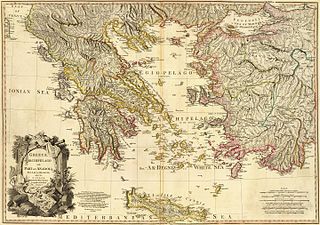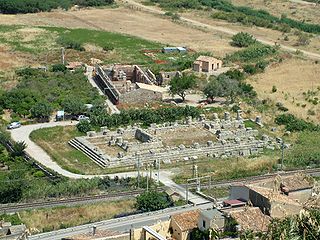
Reggio di Calabria, commonly and officially referred to as Reggio Calabria, or simply Reggio by its inhabitants, is the largest city in Calabria as well as the seat of the Regional Council of Calabria. It has an estimated population between 150,000 and 200,000 and is the twenty-first most populous city in Italy, after Modena and other Italian cities, and the 100th most populated city in Europe. Reggio Calabria is located near the center of the Mediterranean and is known for its climate, ethnic and cultural diversity. It is the third economic centre of mainland Southern Italy. About 560,000 people live in the metropolitan area, recognised in 2015 by Italy as a metropolitan city. Sadly, it holds the record of the worst city in terms of quality of life for environmental and cultural parameters, ranking among the worst Italian cities for quality of life.
This article concerns the period 479 BC – 470 BC.

This is a timeline of ancient Greece from its emergence around 800 BC to its subjection to the Roman Empire in 146 BC.
Ibycus was an Ancient Greek lyric poet, a citizen of Rhegium in Magna Graecia, probably active at Samos during the reign of the tyrant Polycrates and numbered by the scholars of Hellenistic Alexandria in the canonical list of nine lyric poets. He was mainly remembered in antiquity for pederastic verses, but he also composed lyrical narratives on mythological themes in the manner of Stesichorus. His work survives today only as quotations by ancient scholars or recorded on fragments of papyrus recovered from archaeological sites in Egypt, yet his extant verses include what are considered some of the finest examples of Greek poetry.
HieronI was the son of Deinomenes, the brother of Gelon and tyrant of Syracuse in Sicily, from 478 to 467 BC. In succeeding Gelon, he conspired against a third brother, Polyzelos.

Heraclea Pontica, known in Byzantine and later times as Pontoheraclea, was an ancient city on the coast of Bithynia in Asia Minor, at the mouth of the river Lycus. It was founded by the Greek city-state of Megara in approximately 560–558 BC and was named after Heracles who the Greeks believed entered the underworld at a cave on the adjoining Archerusian cape. The site is now the location of the modern city Karadeniz Ereğli, in the Zonguldak Province of Turkey.

A tyrant, in the modern English usage of the word, is an absolute ruler who is unrestrained by law, or one who has usurped a legitimate ruler's sovereignty. Often portrayed as cruel, tyrants may defend their positions by resorting to repressive means. The original Greek term meant an absolute sovereign who came to power without constitutional right, yet the word had a neutral connotation during the Archaic and early Classical periods. However, Greek philosopher Plato saw tyrannos as a negative form of government, and on account of the decisive influence of philosophy on politics, deemed tyranny the "fourth and worst disorder of a state."
Tyrants lack "the very faculty that is the instrument of judgment"—reason. The tyrannical man is enslaved because the best part of him (reason) is enslaved, and likewise, the tyrannical state is enslaved, because it too lacks reason and order.

The Greco-Persian Wars were a series of conflicts between the Achaemenid Empire and Greek city-states that started in 499 BC and lasted until 449 BC. The collision between the fractious political world of the Greeks and the enormous empire of the Persians began when Cyrus the Great conquered the Greek-inhabited region of Ionia in 547 BC. Struggling to control the independent-minded cities of Ionia, the Persians appointed tyrants to rule each of them. This would prove to be the source of much trouble for the Greeks and Persians alike.
Cypselus was the first tyrant of Corinth in the 7th century BC.

Himera, was a large and important ancient Greek city situated on the north coast of Sicily at the mouth of the river of the same name, between Panormus and Cephaloedium in the comune of Termini Imerese.
Aristion was a philosopher who became tyrant of Athens from c. 88 BC until he died in 86 BC. Aristion joined forces with King Mithridates VI of Pontus against Greece's overlords, the Romans, fighting alongside Pontic forces during the First Mithridatic War, but to no avail. On 1 March 86 BC, after a long and destructive siege, Athens was taken by the Roman general Lucius Cornelius Sulla, who had Aristion executed.

Theron, son of Aenesidemus, was a Greek tyrant of the town of Acragas in Sicily in Magna Graecia from 488 BC. According to Polyaenus, he came to power by using public funds allocated for the hire of private contractors meant to assist with a temple building project, to instead hire a personal group of bodyguards. With this force at his disposal, he was able to seize control of the town's government. He soon became an ally of Gelo, who at that time controlled Gela, and from 485 BC, Syracuse. Gelo later became Theron's son-in-law.

Policastro Bussentino is an Italian town and hamlet (frazione) of the municipality of Santa Marina in the province of Salerno, Campania region. It is a former bishopric, now titular see, and has a population of 1,625.
Pythagoras of Samos or Pythagoras of Rhegion was an Ancient Greek sculptor from Samos. Pliny the Elder describes two different sculptors who bore a remarkable personal likeness to each other. In the nineteenth century Dictionary of Greek and Roman Biography and Mythology, Philip Smith accepted the opinion of Karl Julius Sillig (1801–1855) that Pliny's date of Olympiad 87 ought to be referred to a Pythagoras of Samos but not a Pythagoras of Rhegium; other writers considered it possible Pythagoras of Samos lived closer to the beginning of the 5th century BC. Modern writers consider it certain these two were the same artist, and that this Pythagoras was one of the Samian exiles who moved to Zankle at the beginning of the 5th century BC and came under the power of the tyrant Anaxilas in Rhegium. While a Samian by birth, he was a pupil of Clearchus of Rhegium.
Anaxilas or Anaxilaus, son of Cretines, was a tyrant of Rhegium in Magna Graecia. He was originally from Messenia, a region in the Peloponnese.
Scythes was tyrant or ruler of Zancle, Magna Graecia, in Sicily. He was appointed to that post in about 494 BC by Hippocrates of Gela.
Terillus was a son of Crinippus, tyrant of Himera, in Sicily, Magna Graecia.

The siege of Syracuse from 344 to 343/342 BC was part of a war between the Syracusan general Hicetas and the tyrant of Syracuse, Dionysius II. The conflict became more complex when Carthage and Corinth became involved. The Carthaginians had made an alliance with Hicetas to expand their power in Sicily. Somewhat later, the Corinthian general Timoleon arrived in Sicily to restore democracy to Syracuse. With the assistance of several other Sicilian Greek cities, Timoleon emerged victorious and reinstated a democratic regime in Syracuse. The siege is described by the ancient historians Diodorus Siculus and Plutarch, but there are important differences in their accounts.
Leophron was the son of Anaxilas, tyrant of Rhegium and Messana in Magna Graecia. According to Dionysius of Halicarnassus, he succeeded his father in the sovereign power. It is therefore probable that he was the eldest of the two sons of Anaxilas, in whose name Micythus assumed the sovereignty, and who afterwards, at the instigation of Hieron of Syracuse, dispossessed the latter of his authority. Diodorus, from whom we learn these facts, does not mention the name of either of the young princes. According to the same author, their reign lasted six years, when they were expelled by a popular insurrection both from Rhegium and Zancle. Leophron is elsewhere mentioned as carrying on war against the neighbouring city of Locri, and as displaying his magnificence at the Olympic games, by feasting the whole assembled multitude. His victory on that occasion was celebrated by Simonides.








